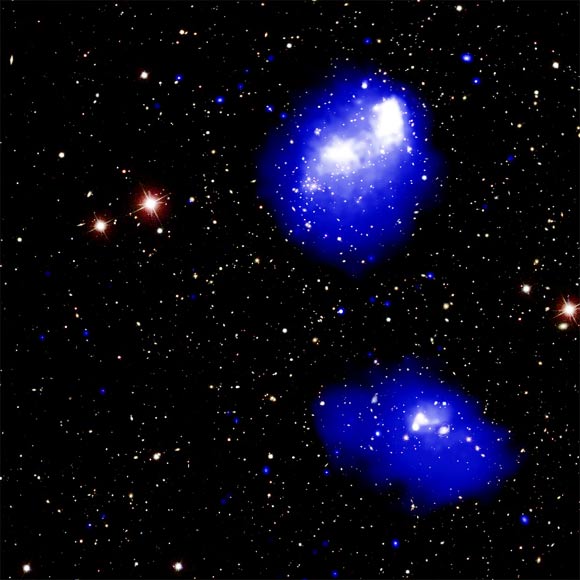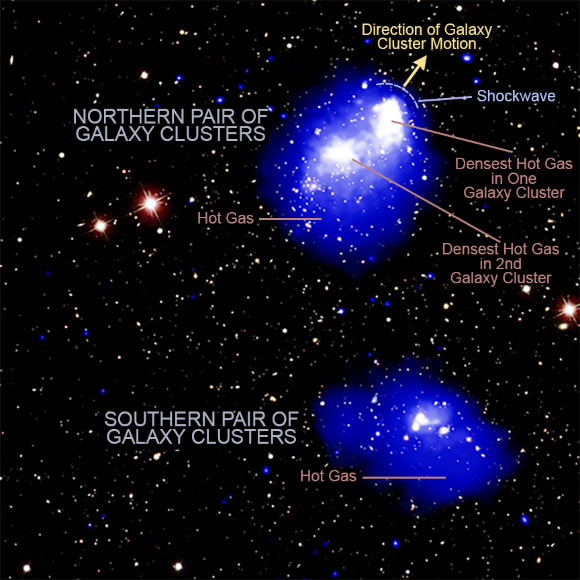Chandra Observes Mega-Merger of Galaxy Clusters: Abell 1758 | Astronomy – Sci-News.com
Using data from NASA’s Chandra X-ray Observatory, astronomers have created detailed maps of Abell 1758, a collision between two pairs of galaxy clusters, each with hundreds of galaxies embedded in large amounts of hot gas and unseen dark matter; eventually all these clusters will merge to form one of the most massive objects in the Universe.

This composite image shows Abell 1758, a quadruple galaxy cluster system about 3 billion light-years away from Earth. In the northern (top) pair seen in the image, the centers of each cluster have already passed by each other once, about 300 to 400 million years ago, and will eventually swing back around. The southern pair at the bottom of the image has two clusters that are close to approaching each other for the first time. X-rays from Chandra are shown as blue and white, depicting fainter and brighter diffuse emission, respectively. This image also includes an optical image from the Sloan Digital Sky Survey (SDSS). Image credit: NASA / CXC / SAO / G. Schellenberger et al / SDSS.
Astronomers first recognized Abell 1758 as a quadruple galaxy cluster system in 2004 using data from Chandra and ESA’s XMM-Newton satellite.
Located about 3 billion light-years from Earth, it is made up of two galaxy clusters, a more massive, northern cluster and a southern cluster. Both parts are undergoing major merger events at different stages.
In a new study, Dr. Gerrit Schellenberger of the Harvard-Smithsonian Center for Astrophysics and colleagues used NASA’s Chandra X-ray Observatory to produce detailed temperature and abundance maps of the mega-merger.
The Chandra data revealed a shock wave — similar to the sonic boom from a supersonic aircraft — in hot gas visible in the northern pair’s collision.
From this shock wave, the researchers estimate two clusters are moving about 2 million to 3 million mph (3-5 million kmh), relative to each other.

An annotated image of Abell 1758 system. Image credit: NASA / CXC / SAO / G. Schellenberger et al / SDSS.
The Chandra data also provide information about how elements heavier than helium, the ‘heavy elements,’ in galaxy clusters get mixed up and redistributed after the clusters collide and merge.
Because this process depends on how far a merger has progressed, Abell 1758 offers a valuable case study, since the northern and the southern parts are at different stages of merging.
In the southern part, the heavy elements are most abundant in the centers of the two colliding clusters, showing that the original location of the elements has not been strongly impacted by the ongoing collision.
By contrast, in the northern pair, where the collision and merger has progressed further, the location of the heavy elements has been strongly influenced by the collision.
The highest abundances are found between the two cluster centers and to the left side of the cluster pair, while the lowest abundances are in the center of the cluster on the left side of the image.
Collisions between clusters affect their component galaxies as well as the hot gas that surrounds them.
The data from the 6.5-m MMT telescope in Arizona show that some galaxies are moving much faster than others, probably because they have been thrown away from the other galaxies in their cluster by gravitational forces imparted by the collision.
The team also used radio data from the Giant Metrewave Radio Telescope and X-ray data from ESA’s XMM-Newton mission.
The results were published in the Astrophysical Journal.
_____
G. Schellenberger et al. 2019. Forming One of the Most Massive Objects in the Universe: The Quadruple Merger in Abell 1758. ApJ 882, 59; doi: 10.3847/1538-4357/ab35e4






